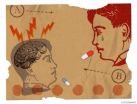(Press-News.org) A breakthrough in a University of Cincinnati engineering lab that could clear the way for a low-cost, even disposable, e-reader is gaining considerable attention.
Electrical Engineering Professor Andrew Steckl's research into an affordable, yet high-performance, paper-based display technology is being featured this week as the November cover story of ACS Applied Materials and Interfaces, one of the scientific journals for the American Chemical Society, the world's largest scientific society.
In the research, Steckl and UC doctoral student Duk Young Kim demonstrated that paper could be used as a flexible host material for an electrowetting device. Electrowetting (EW) involves applying an electric field to colored droplets within a display in order to reveal content such as type, photographs and video. Steckl's discovery that paper could be used as the host material has far-reaching implications considering other popular e-readers on the market such as the Kindle and iPad rely on complex circuitry printed over a rigid glass substrate.
"One of the main goals of e-paper is to replicate the look and feel of actual ink on paper," the researchers stated in the ACS article. "We have, therefore, investigated the use of paper as the perfect substrate for EW devices to accomplish e-paper on paper."
Importantly, they found that the performance of the electrowetting device on paper is equivalent to that of glass, which is the gold standard in the field.
"It is pretty exciting," said Steckl. "With the right paper, the right process and the right device fabrication technique, you can get results that are as good as you would get on glass, and our results are good enough for a video-style e-reader."
Steckl imagines a future device that is rollable, feels like paper yet delivers books, news and even high-resolution color video in bright-light conditions.
"Nothing looks better than paper for reading," said Steckl, an Ohio Eminent Scholar. "We hope to have something that would actually look like paper but behave like a computer monitor in terms of its ability to store information. We would have something that is very cheap, very fast, full-color and at the end of the day or the end of the week, you could pitch it into the trash."
Disposing of a paper-based e-reader, Steckl points out, is also far simpler in terms of the environmental impact.
"In general, this is an elegant method for reducing device complexity and cost, resulting in one-time-use devices that can be totally disposed after use," the researchers pointed out.
Steckl's goal is attract commercial interest in the technology for next-stage development, which he expects will take three to five years to get to market.
INFORMATION:
The work was supported, in part, by a grant from the National Science Foundation and was conducted at the Nanoelectronics Laboratory at the University of Cincinnati College of Engineering and Applied Science.
UC breakthrough may lead to disposable e-Readers
2010-11-23
ELSE PRESS RELEASES FROM THIS DATE:
Uptake protein acts as zinc's doorway to the cell
2010-11-23
UPTON, NY — A study to be published as the "Paper of the Week" in the Journal of Biological Chemistry this December details how zinc, an element fundamental to cell growth, enters the cell via zinc-specific uptake proteins. The research, conducted at the U.S. Department of Energy's (DOE) Brookhaven National Laboratory, is the first to purify this kind of protein and study its role in zinc uptake.
Zinc is crucial to the health of all living organisms. At the cellular level, zinc is responsible for cell growth, which in turn affects the health, growth, and reproduction ...
A first-time study in Spain analyzes gambler perception
2010-11-23
Another conclusion of the report is that the amount of money played is underestimated: on average, a gambler who thinks he has bet 22 euros a month, in reality has bet 40 euros. Regarding on line gambling, the player stands out more as an internaut than as a gambler. "They think that they are browsing the net, going into pages of this type and gambling, believing that they are still browsing. On the other hand, in the case of conventional gambling, if you are going to make a bet on football scores, playing instant lottery, buying a lottery ticket, or taking part in ...
Medical imaging breakthrough uses light and sound to see microscopic details inside our bodies
2010-11-23
See it for yourself: a new breakthrough in imaging technology using a combination of light and sound will allow health care providers to see microscopic details inside the body. Access to this level of detail potentially eliminates the need for some invasive biopsies, but it also has the potential to help health care providers make diagnoses earlier than ever before—even before symptoms arise. Details describing this advance are published online in the FASEB Journal (http://www.fasebj.org/content/early/2010/11/19/fj.10-171728.abstract).
In the online research report, ...
New sleep cycle discovery explains why fatty diets during pregnancy make kids obese
2010-11-23
The link between sleeping and obesity is drawn tighter as a new research published online in the FASEB Journal (http://www.fasebj.org/content/early/2010/11/19/fj.10-172080.abstract) study shows that what your mother ate when she was pregnant may make you obese or overweight by altering the function of genes (epigenetic changes) that regulate circadian rhythm. In the report, pregnant primate females consuming a high-fat diet altered the function of fetal genes that regulate circadian rhythm (including appetite and food intake) during development. The offspring also had non-alcoholic ...
Late-preterm babies at greater risk for problems later in childhood
2010-11-23
EAST LANSING, Mich. — Late-preterm babies – those born between 34 and 36 weeks – are at an increased risk for cognitive and emotional problems, regardless of maternal IQ or demographics, according to new research published by Michigan State University researchers in the current edition of the journal Pediatrics.
While late-preterm births (full-term pregnancies last at least 37 weeks) have been associated with such problems before, the study represents one of the most rigorous looks at the issue by accounting for other potential causes, said the study's lead author, Nicole ...
More than half of depression patients give up their treatment
2010-11-23
Most patients who take anti-depressants give up their treatment in less than six months, the minimum period recommended for treating severe depression and other derived pathologies. This is the conclusion of a new study carried out by Catalan researchers, which reveals that only 25% continue their treatment for more than 11 months.
"Only one in every five patients properly completes their treatment", Catalina Serna, co-author of the study, and an expert at the Jordi Gol Primary Care Research Institute (IDIAP) in Lleida, tells SINC.
From 2003 to 2007, researchers from ...
Stability is first step toward treating ALS
2010-11-23
Amyotrophic lateral sclerosis (ALS) is a fatal neurodegenerative disease that eventually destroys most motor neurons, causing muscle weakness and atrophy throughout the body. There is no cure and the current treatment has only a moderate effect on the march of the disease, which typically kills within three to five years. This week in PNAS, a team of Brandeis scientists reports an innovative approach to treating the most common form of familial ALS, commonly known as Lou Gehrig's disease.
In the study, researchers studied mutations in the gene that makes a particular ...
Imaging science offers new opportunities for interdisciplinary collaboration
2010-11-23
Nov. 22, 2010 -- More than 170 participants gathered this week for the eighth annual National Academies Keck Futures Initiative (NAKFI) conference in Irvine, Calif. This year's topic, imaging science, a field of study that uses physics, chemistry, mathematics, computer science, and cognitive sciences to understand the many factors that influence and enable image capture and analysis. At the conference, top researchers from different fields discussed imaging science and its far-reaching applications -- such as astronomy, environmental monitoring, education, and health ...
Protein found to predict brain injury in children on 'ECMO' life support
2010-11-23
Johns Hopkins Children's Center scientists have discovered that high blood levels of a protein commonly found in the central nervous system can predict brain injury and death in critically ill children on a form of life support called extra-corporeal membrane oxygenation or ECMO.
ECMO, used to temporarily oxygenate the blood of patients whose heart and lungs are too weak or damaged to do so on their own, is most often used as a last resort because it can increase the risk for brain bleeding, brain swelling, stroke and death in some patients.
A detailed report of the ...
For HIV-positive patients, delayed treatment a costly decision
2010-11-23
HIV infected patients whose treatment is delayed not only become sicker than those treated earlier, but also require tens of thousands of dollars more in care over the first several years of their treatment.
"We know that it's important clinically to get people into care early because they will stay healthier and do better over the long run," says Kelly Gebo, M.D., M.P.H., an associate professor of medicine in the Division of Infectious Diseases at the Johns Hopkins University School of Medicine and the study's senior author. "But now we know it's also more costly to ...



